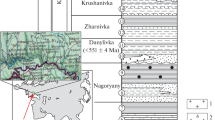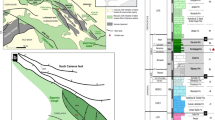Abstract
The Güzelöz-İncesu Plateaus are situated in the central and eastern parts of the Cappadocian volcanic province (central Anatolia). This province contains many ignimbrite levels, andesite, basalt intercalated with several paleosols, calcrete, carbonate, fluvial sediments, diatomaceous clayey sediments and pyroclastic sedimentary levels. The presence of mottling, sesquioxide, root traces, rhizoids and burrows in continuous, finely bedded and laminated sediments, paleosols, calcrete, the occurrence of bone- and teeth-bearing reworked pyroclastic materials, and the description of the lithofacies in the study area indicate fluvial and shallow-lake environments. These environments are dominated by smectite and illite, with traces of kaolinite, associated mainly with plagioclase, K-feldspar, quartz, calcite, opal-CT, pyroxene (diopside, rare hypersthene), and locally trace amounts of gypsum and sepiolite. Smectite predominates in paleosols and calcrete units, and generally increases upwards in the profiles, coinciding with a gradual increase in the degree of alteration. Partial to complete alteration of plagioclase, K-feldspar, pyroxene and partial devitrification of glass-shard particles in pyroclastic rocks, development of microsparitic to sparitic cement comprising euhedral rhombic calcite crystals between irregular clay nodules in paleosol and calcrete samples, along with the occurrence of dogtooth-type sparitic crystals in fractures, desiccation cracks and geopetal-type fenestrae, indicate alternating periods of drought and wet, resulting in the development of paleosols and calcretes. Micromorphological development of spongiform smectite on mainly relict feldspar and, locally, on glass shards, indicates an authigenic origin, whereas illite formed either authigenically or by conversion of smectite to illite-smectite.
Similar content being viewed by others
References
Akbulut, A. and Kadir, S. (2003) The geology and origin of sepiolite, palygorskite and saponite in Neogene lacustrine sediments of the Serinhisar-Acıpayam basin, Denizli, SW Turkey. Clays and Clay Minerals, 51, 279–292.
Arslan, M., Kadir, S., Abdioğlu, E. and Kolayli, H. (2006) Origin and formation of kaolin minerals in saprolite of Tertiary alkaline volcanic rocks, Eastern Pontides, NE Turkey. Clay Minerals, 41, 597–617.
Batum, I. (1975) Petrographische und geochemische Untersuchungen in den Vulkangebieten Göllü Dağ und Acıgöl (Zentralanatolien/Türkei). PhD thesis, Freiburg University, Germany, 101 pp.
Batum, I. (1978) Geology and petrography of the Göllüdağ and Acigöl volcanics in the southwestern Nevşehir. Bulletin of Earth Sciences Application and Research Centre of Hacettepe University, Ankara, Turkey, 4/1–2, 50–69 (in Turkish with English abstract).
Besang, C., Eckhardt, F.J., Harre W., Kreuzer, H. and Müller, P. (1977) Radiometrische Altersbestimmungen an Neogenen eruptivgesteinen der Turkei. Geologisches Jahrbuch, B25, 3–36.
Bethke, C.M. and Altaner, S.P. (1986) Layer-by-layer mechanism of smectite illitization and application to a new rate law. Clays and Clay Minerals, 34, 136–145.
Bigazzi, G., Yeğingil, Z., Boztuğ, D., Ercan, T., Norelli, P. and Özdoğan, M. (1997) Studi di Proveinenza della obsidiana con il metodo tracce di fissione: nuovi dati sulle Potenziali fonti Anatoliche. IV Giornata ‘Le Scienze della Terra e 1’ Archeometria’, Naples, Abstracts, p. 33.
Brindley, G.W. (1980) Quantitative X-ray analysis of clays. Pp. 411–438 in: Crystal Structures of Clay Minerals and their X-ray Identification (G.W. Brindley and G. Brown, editors). Mineralogical Society Monograph 5, London.
Duritt, T.H., Brenchley, P.J., Gökten, Y.E. and Francaviglia, V. (1995) Late Quaternary rhyolitic eruptions from the Acigöl complex, Central Turkey. Journal of the Geological Society, London, 152, 655–667.
Ercan, T., Köse, C., Akbaşlı, A. and Yıldırım, T. (1987) Orta Anadolu’da Nevşehir-Niğde-Konya dolayındaki volkanik kökenli gaz çıkışları. Cumhuriyet Üniversitesi Mühendislik Fakültesi Dergisi, Seri A, Yerbilimleri, 4, 57–63.
Ercan, T., Yeğingil, Z. and Biggazi, G. (1989) Obsidiyen tanımı ve özellikleri, Anadolu’daki dağılımı ve Orta Anadolu obsidiyenlerinin jeokimyasal nitelikleri. Jeomorfoloji Dergisi, 17, 71–83.
Erol, O. (1999) A geomorphological study of the Sultansazliği lake, central Anatolia. Quaternary Science Reviews, 18, 647–657.
Gabriel, M. and Malecha, A. (1972) Evaluation of diatomite deposits near Belisirma and Ihlara and of occurences near Ürgüp (Niğde) and Çerkeş (Çankırı) Turkey. The Etibank Rapport, (unpublished) Ankara, 17 pp.
Galán, E. and Ferrero, A. (1982) Palygorskite-sepiolite clays of Lebrija, southern Spain. Clays and Clay Minerals, 30, 191–199.
Gevrek, A.İ. (1997) Aksaray doğusu, Ihlara-Derinkuyu yöresindeki volkaniklastiklerin sedimentolojisi. Doktora Tezi, A. Ü. Fen Bilimleri Enstitüsü 178 pp (in Turkish).
Göncüoğlu, M.C. and Toprak, V. (1992) Neogene and Quaternary volkanism of Central Anatolia: a volcano structural evoluation. Bulletin de la Section de Volcanologie, Societè Geologique de France, 26, 1–6.
Hay, R.L. and Reeder, R.J. (1978) Calcretes of Olduvai Gorge and the Ndolanya Beds of northern Tanzania. Sedimentology, 25, 649–673.
Henderson, J.H., Jackson, M.L., Syers, J.K., Clayton, R.N. and Rex, R.W. (1971) Cristobalite authigenic origin in bentonites. Clays and Clay Minerals, 19, 229–238.
Hower, J., Eslinger, E.V., Hower, M. and Perry, E.A. (1976) Mechanism of burial metamorphism of argillaceous sediments, I. Mineralogical and chemical evidence. Geological Society of American Bulletin, 87, 725–737.
Iijima, A. (1980) Geology of natural zeolites and zeolitic rocks. Pp. 103–118 in: Proceedings of the 5th International Conference on Zeolites, Naples, vol. 1. Heyden, London.
Iijima, A. and Tada, R. (1981) Silica diagenesis of Neogene diatomaceous and volcaniclastic sediments in northern Japan. Sedimentology, 28, 185–200.
Innocenti, F., Mazzuoli, G., Pasquaré, F., Radicati Di Brozolo, F. and Villari, L. (1975) The Neogene calcalkaline volcanism of Central Anatolia — geochronological data on Kayseri-Niğde area. Geological Magazine, 112, 349–360.
Jones, J.B. and Segnit, E.R. (1971) The nature of opal I. Nomenclature and constituent phases. Journal of the Geological Society of Australia, 18, 57–68.
Kadir, S. and Karakaş, Z. (2002) Mineralogy, chemistry and origin of halloysite, kaolinite and smectite from Miocene ignimbrites, Konya, Turkey. Neues Jahrbuch für Mineralogie, Abhandlungen, 177, 113–132.
Kadir, S., Baş, H. and Karakaş, Z. (2002) Origin of sepiolite and loughlinite in a Neogene sedimentary lacustrine environment, Mihalıçık-Eskişehir, Turkey. The Canadian Mineralogist, 40, 1091–1102.
Karakaş, Z. and Kadir, S. (1998) Mineralogical and genetic relationships between carbonate and sepiolite-palygorskite formations in the Neogene lacustrine Konya Basin, Turkey. Carbonates and Evaporites, 13, 198–206.
Kastner, M. (1979) Silica polymorphs. Pp. 99–106 in: Marine Minerals (R.G. Burns, editor). Short Course Notes, 6, Mineralogical Society of America, Washington D.C.
Le Pennec, J.L., Bourdier, J.L., Froger, A., Temel, A., Camus, G. and Gourgaud, A. (1994) Neogene ignimbrites of the Nevşehir Plateau (central Turkey): stratigraphy, distribution and source constrains. Journal of Volcanology and Geothermal Research, 63, 59–87.
Le Pennec, J.L., Temel, A., Froger, J.L., Sen, S.G., Gourgaud, A. and Bourdier, J.L. (2005) Stratigraphy and age of the Cappadocia ignimbrites, Turkey: reconciling field constraints with paleontologic, radiochronologic, geochemical and paleomagnetic data. Journal of Volcanology and Geothermal Research, 141, 45–64.
Miall, A.D. (1996) The Geology of Fluvial Deposits. Sedimentary Facies, Basin Analysis, and Petroleum Geology. Springer, Berlin, 582 pp.
Moore, D.M. and Reynolds, R.C. (1989) X-ray Diffraction and the Identification and Analysis of Clay Minerals. Oxford University Press, New York, 332 pp.
MTA (1989) 1/100,000 Scale Geological Map of Turkey Kayseri-I19. The General Directorate of Mineral Research and Exploration of Turkey.
Noel, D. (1984) Les diatomèes des scumures et des sediménts de surface du Salin de Bros del port (Santa pola province d’Alicante, Espagne). Revista Instituto Investigaciones Geologicas, Barcelona, 38–39, 79–107.
Pasquaré, G. (1968) Geology of the Cenozoic volcanic area of Central Anatolia. Atti Accademei Nazionale dei Lincei Memoire, 9, 55–204.
Pasquaré, G., Poli, S., Venzolli, L. and Zanchi, A. (1988) Continental arc volcanism and tectonic setting in Central Anatolia, Turkey. Tectonophysics, 146, 217–230.
Rask, J.H., Bryndzıa, L.T., Braunsdorf, N.R. and Murray, T.E. (1997) Smectite illitization in Pliocene-age Gulf of Mexico mudrocks. Clays and Clay Minerals, 45, 99–109.
Retallack, G.J. (1988) Field recognition of paleosols. Pp. 1–20 in: Paleosols and Weathering through Geologic Time Techniques and Applications (J. Reinhardt and W.R. Sigleo, editors). Special Paper, 216, Geological Society of America, Boulder, Colorado.
Riding, R. and Wright, V.P. (1981) Paleosols and tidal flat-lagoon sequences on a Carboniferous carbonate shelf. Journal of Sedimentary Petrology, 51, 1323–1339.
Scholle, P.A. (1978) A color illustrated guide to carbonate rock constituents, textures, cements and porosities. Memoirs of the American Association of Petroleum Geology, 27, 241.
Schreiber, B.C. and El Tabakh, M. (2000) Deposition and early alteration of evaporites. Sedimentology, 47, 215–238.
Schumacher, R., Keller, J. and Bayhan, H. (1990) Depositional characteristics of ignimbrites in Cappadocia, Central Anatolia, Turkey. Pp. 435–449 in: Proceedings of the International Earth Science Congress on Aegean Regions (IESCA-1990), vol. 2 (M.Y. Savaşçın and A.H. Eronat, editors).
Schumacher, R. and Schumacher, U.M. (1996) The Kızılkaya ignimbrite an unusual low-aspect-ratio ignimbrite from Cappadocia, Central Turkey. Journal of Volcanolgy and Geothermal Research, 70, 107–121.
Siesser, W.G. (1973) Diagenetically formed ooids and intraclasts in South African calcretes. Sedimentology, 20, 539–551.
Singer, A. and Galán, E., editors (1984) Palygorskite-Sepiolite; Occurrence, Genesis and Uses. Development in Sedimentology, 37, Elsevier, Amsterdam, 352 pp.
Stamatakis, M.G., Hein, J.R. and Magganas, A.C. (1989) Geochemistry and diagenesis of Miocene lacustrine siliceous sedimentary and pyroclastic rocks, Mytilinii basin, Greece. Sedimentary Geology, 64, 65–78.
Temel, A., Gündoğdu, M.N., Gourgaud, A. and Le Pennec, J.L. (1998) Ignimbrites of Cappadocia Central Anatolia, Turkey: petrology and geochemistry. Journal of Volcanology and Geothermal Research, 85, 447–471.
Toprak, V., Keller, J. and Schumacher, R. (1994) Volcano-tectonic features of the Cappadocian Volcanic Province. International Volcanological Congress, Excursion Guide, Ankara, 58 pp.
Toprak, V. (1996) The origin of the Quaternary basins which have been developed in the Cappadocia volcanic subsidence, Central Anatolia. 30th annual symposium, Black Sea Technical University, Trabzon (in Turkish), pp. 326–340.
Tucker, M.E. and Bathurst, R.G.C. (1990) Carbonate Diagenesis. Blackwell Scientific Publications, Oxford, UK, 1, 312 pp.
Türkecan, A., Dönmez, M. and Akçay, E.A. (2003) Tertiary volcanics of Kayseri-Niğde-Nevşehir areas. Mineral Research and Exploration Report, no. 10575 (unpublished), Ankara (in Turkish).
Uygun, A. (1976) Geologie und Diatomit Vorkommen des Neogen-Beckens von Emmiler-Hırka (Kayseri-Türkei), PhD thesis, Bonn Universitaet, Germany, 137 pp.
Viereck-Götte, L. and Gürel, A. (2003) Klima- und Vegetationswechsel dokumentiert in Obermiozaenen Paläoböden Kappadokiens, Zentralanatolien. Berichte der Deutschen Mineralogischen Gesellschaft. Beihefte zum European Journal of Mineralogy, 15, 211 pp., Stuttgart, Germany.
Warren, J.K. (1982a) The hydrological significance of Holocene tepees, stromatolites, and boxwork limestones in coastal salines in South Australia. Journal of Sedimentary Petrology, 52, 1171–1201.
Warren, J.K. (1982b) The hydrological setting, occurrence and significance of gypsum in late Quaternary salt lakes in South Australia. Sedimentology, 29, 609–637.
Wright, V.P. (1982) Calcrete paleosol from Carboniferous Llanelli Formation, South Wales. Sedimentary Geology, 33, 1–33.
Wright, V.P. (1983) A rendzina from the Lower Carboniferous of South Wales. Sedimentology, 30, 159–179.
Wright, V.P. (1986) The role of fungal biomineralization in the formation of Early Carboniferous soil fabrics. Sedimentology, 33, 831–838.
Wright, V.P. (1987) The ecology of two early Carboniferous paleosols: Pp. 345–358 in: European Dinantian Environments (J. Miller, A.E. Adams and V.P. Wright, editors). Geological Journal Special Issue, 12, Wiley, London.
Wright, V.P. and Tucker, M.E. (1991) Calcretes. The International Association of Sedimentologists, Oxford, London, 352 pp.
Wright, V.P., Platt, N.H. and Wimbledon, W.A. (1988) Biogenic laminar calcretes: evidence of calcified root-mat horizons in paleosols. Sedimentology, 35, 603–620.
Author information
Authors and Affiliations
Corresponding author
Rights and permissions
About this article
Cite this article
Gürel, A., Kadır, S. Geology, mineralogy and origin of clay minerals of the Pliocene fluvial-lacustrine deposits in the Cappadocian volcanic province, central Anatolia, Turkey. Clays Clay Miner. 54, 555–570 (2006). https://doi.org/10.1346/CCMN.2006.0540503
Received:
Revised:
Published:
Issue Date:
DOI: https://doi.org/10.1346/CCMN.2006.0540503




